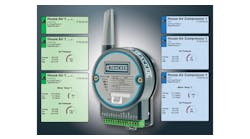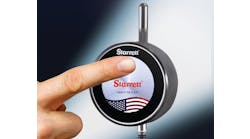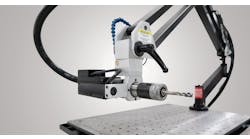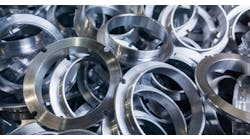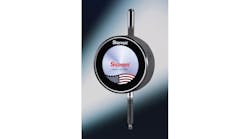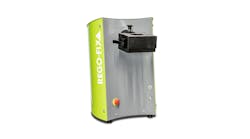The performance, reliability and longevity of machined parts often depend on the physical characteristics of their functional surfaces. However, legacy surface roughness parameters, such as Ra, are frequently insufficient to reliably predict surface function. The need for functional surface metrology parameters extending beyond roughness information drove the creation of true three-dimensional (3D) areal surface parameters, denoted as S parameters. ISO standardization for the computations made to provide those data is found in ISO 25178-2. This article reviews the definitions of some of these parameters and shows how they correlate with part function. It also describes how the 3D optical microscope is able to accurately, repeatably, and reproducibly provide data for computation of these surface parameters for virtually any machined surface, and provides some examples of the utility of these S parameters.
Roughness and statistical parameters
With traditional, two-dimensional surface metrology a tool such as a stylus profilometer is used to measure the height (z) of every point (x) along a straight line. In three-dimensional surface metrology, an instrument such as a 3D optical microscope or atomic force microscope measures an areal data set that is the z height of a very large number of xy surface points over the instrument’s field of view or scan range. (The effective size of a point or pixel is defined by instrument hardware and software filters.) The raw dataset is very large, so it becomes necessary to reduce it to just a few statistical parameters that can be used for “pass/fail” testing, or for defining surface metrics to enable process evaluation and improvements.
For many years, so-called R parameters were used to define surface roughness. These parameters are two-dimensional, which made sense when the only measurements were two-dimensional. The most widely used of these parameters is Ra, which is the arithmetic mean value of all the z values relative to the average z value, i.e., the average deviation, up and down, from the mean x axis line sampled by the instrument. Second order R parameters were later developed with higher order z dependence, for example, in an attempt to statistically summarize the moments of the measured profile (the distribution of the heights of the deviations). But all these R parameters are two-dimensional in nature, that is, a measure of z relative to x. However, structural, and more importantly, functional properties of machined surfaces are three-dimensional functions. The limitations of using Ra can be seen in Figure 1.
Figure 1. 3D optical microscope images of three very different surfaces — indistinguishable by Ra.
Areal S parameters
This limitation can now be addressed using ISO-defined 3D parameters, which can be measured and computed using the latest metrology instruments, such as the 3D optical microscope. Specifically, ISO 25178-2 defines several amplitude-based areal parameters based on overall heights, such as Sa, Sdq, Sku and Ssk, as well as spatial parameters based on frequencies of features, such as Std.
In addition, the advent of smart surface metrology instruments with on-board computation has enabled the development and use of several hybrid parameters based on height and frequency, such as Sdr. And potentially most useful of all, this new generation of instruments now supports the measurement of functional surface parameters such as Sbi and Svi.
What do these new parameters entail?
Sdq is defined as the root mean squared (RMS) surface slope, in degrees. In simple terms, Sdq is the measure of the sharpness of surface features. A higher Sdq value corresponds to a surface with sharper, more pointed features.
Ssk and Sku are mathematical representations that define the skew and kurtosis of the 3D surface texture. Specifically, if the heights of the surface features are plotted as a histogram, they will follow a statistical distribution based on the structure of the surface relative to the mean plane. The Ssk and Sku parameters define the shape of this distribution. Ssk is a (dimensionless) definition of the asymmetry of this distribution, i.e., a positive value indicates a preponderance of points above the mean plane (peaks), whereas a negative value indicates a preponderance of troughs or valleys relative to this plane. Sku is a measure of the wings of the distribution; a normal distribution (Gaussian with mean centered at zero) has a Sku value of 3.0; values higher than this indicate the presence of inordinately high peaks and valleys.
Std is the texture direction of the surface. Most pits, scratches and burrs do not have a symmetrical circular shape in the xy plane. Rather, they are longer in one direction, an extreme example being a scratch or residual leading (threading) from lathe turning. Std is the effective sum of all these vectors, i.e., their net direction. If the part has been produced by a more random process, such as grinding, there may be no net texture direction. But if a part is produced by turning, Std and Sa can be used to measure residual leading (see the case study section).
Sdr is a hybrid parameter called the developed interfacial area. Expressed as a percentage, it is a measure of the additional surface area due to texture: a rougher surface has a higher value of Sdr.
Functional parameters give information about how a surface will contact a seal lip or other surface, e.g., how it will wear and how well it will retain lubricant. For these purposes, the tested surface is characterized by three surface depth regions (see Figure 2). These are peak height or the first region of contact, the core height or base/working region, and the valley depth or lubricant retention region. That surfaces with higher Svi will retain fluid more readily is one example of the utility of functional surface parameter metrology.
Figure 2. Surface texture functional parameters are defined relative to three different depth regimes: logically called peaks, core and valleys.
Sbi is the surface bearing index. It is a measure of how many peaks are above the core height for these features. For a normal distribution of peak heights, Sbi is 0.61. Higher values than this indicate a good bearing surface. Sci is the core fluid retention index. For a normal distribution of surface features, Sci is 1.56; values smaller than this indicate a smoother surface. Svi is the valley fluid retention index. For a normal distribution, Svi equals 0.11. Values higher than this indicate a surface with superior fluid retention.
Finally, it is important to note that these are just some of the more useful S parameters in use today. Table 1 is a more comprehensive list of commonly used S surface parameters.
Table 1
Amplitude parameters (based on overall heights):
Sa —The mean roughness of the surface
Sq — The root-mean-square deviation (RMS of height distribution)
Ssk — Skewness, the degree of asymmetry of a surface height distribution
Sku — Kurtosis, the frequency of the distribution of peak points across a surface
Sz — Average of ten highest and lowest points
Spatial Parameters (based on frequencies of features):
Sds — Density of summits
Str — Texture aspect ratio
Sal — Fastest decay autocorrelation length
Std — Texture direction of surface
Hybrid Parameters (based on a combination of height and frequency):
Sdq — Root-mean-square surface slope
Ssc — Mean summit curvature
Sdr — Developed surface area ratio
Functional Parameters (based on applicability for particular functions):
Sbi — Surface bearing index
Sci — Core fluid retention index
Svi — Valley fluid retention index
A gage-capable areal metrology tool
Obtaining these S parameters requires a tool capable of acquiring detailed xyz surface profiles over a statistically significant area under test, and which is equipped with onboard software to process this huge raw data set. Several surface metrology instruments can provide some of this data, but only one of these can currently deliver the high speed, lack of operator bias, and rugged reliability needed to support high-throughput machining operations. This tool is the 3D optical microscope.
Figure 3. The Bruker ContourGT-X is an example of a 3D optical microscope.
The 3D optical microscope (see Figure 3) is based on a technique called white light interferometry. Parts are analyzed by placing them on the microscope stage (in lab settings) or by bringing larger parts and machined surfaces to the focal plane using off-the-shelf, applications-specific hardware. In operation, the 3D optical microscope then uses light waves as a high-resolution ruler or depth gauge. This allows the microscope’s computer to obtain a full 3D profile over the entire field of view of the camera as the sample is quickly and automatically stepped through focus. The entire data acquisition and analysis is completed in just a few seconds.
In addition to high speed, the 3D optical microscope offers the advantages of non-contact (i.e., non-destructive) testing, sub-nanometer precision, high dynamic range, and flexibility. Specifically, the z axis (vertical) resolution can be as fine as 0.01 nanometers, whereas the resolution and field of view in the xy plane are determined by magnifying the interchangeable objectives. Also, the 3D optical microscope is characterized by a high linear dynamic range, providing vertical resolution of better than 0.01 nanometers over a range of feature heights up to 10 millimeters. Furthermore, the ability to optimize the field of view (i.e., to zoom in or out using different objectives) provides range flexibility in the xy plane. This is an important and unique benefit as it enables large scale and super-fine microscopic details to be obtained in the same test (see Figure 4).
Figure 4. False color data of a sawed silicon surface tested at three different xy resolutions by automatically recording data with three different microscope objectives. The largest field of view clearly shows residual saw damage (waviness) that would be missed at the highest resolution used to measure roughness.
Importantly, this new generation of metrology instruments uses an on-board computer equipped with software that automatically performs the surface scans and also calculates various S parameters from the raw data. Moreover, these S parameters can be determined over a spatial frequency range determined by short and long-range cut-off filters that are set by the user. Another important component of this dedicated software suite is called Multiple Region Analysis. This can be programmed to automatically identify regions of interest, based on damage patterns, roughness or other surface criteria. The software then zooms in to conduct a detailed analysis of this area(s).
The complete software suite includes both Production Mode and Data Management modules. These twin modules can be used to streamline the surface evaluation process, eliminate operator subjectivity, and enable tiered software access to support operation by R&D engineers through QA technicians.
Longer-life rotary seals in automobiles
There are 80 or more dynamic seals in a typical automobile1; Many of these involve shafts that are produced by some type of turning process. This leaves a threading pattern (lead) that must be removed by plunge grinding or other processes. (Excessive lead causes the seals to leak fluid.) Until now, there had been no quantitative and gage-capable method to measure lead angle for sealing applications. Because of the nature of manufacturing improvements and enhanced warranty issues, metrology to meet a typical sealing surface specification of ±0.05 degrees is increasingly in demand.
Traditionally, the lead for engine and transmission seals could be measured using a legacy method that involves hanging a weight on a piece of cotton quilting thread wrapped around the shaft and measuring the motion as the shaft is rotated. Unfortunately, this methodology exhibits high operator dependence and is not a gage-capable method for measuring shaft lead. To improve seal longevity and reduce the consumption of oil and other fluids, some manufacturers of automobile engines are specifying a nominal zero degree lead angle that cannot be quantified with this string method. The 3D optical microscope is now proving to be a superior, gage-capable and automated alternative for these manufacturers that readily delivers the necessary sensitivity, eliminates operator subjectivity and enables measurement of “micro lead.”
Specifically, the instrument detects all the surface grooves and micro-pits, not just those coarse enough and long enough to catch a piece of string. Then, these are analyzed for Std, the texture direction index of the shaft surface, as well as for other characteristic parameters that allow for highly accurate determination of the lead on the surface.
Figure 5. Stock either maintained an acceptable surface finish (left) or corroded (right) following processing. 3D parameters helped to trace the difference to a predominance of deep valleys that Ra did not discern.
Reducing surface corrosion
Surface bearing parameters, Sbi Svi, and Sci, are commonly used to evaluate how a surface will hold lubricant and/or how it will wear over time. But a recent example shows a very different use for this surface bearing index, namely, how it will corrode. A manufacturer of brand name consumer products, had found their incoming ASTM 366 coil steel stock was conforming to an average roughness specification of Ra = 20-70 micro-inches. Yet a significant portion of the stock was found to corrode following a series of cold working and surface treatment processes.
Then, they investigated using a 3D optical microscope to perform 3D measurement and statistical analysis of the surface. Faster corrosion was found to correlate with the presence of deeper valleys, presumably because these retain processing solutions and do not rinse well. They subsequently developed testing protocols based on parameters derived from the bearing area analysis that proved an excellent indicator of the incoming stock’s tendency to corrode.
Bonding of machined surfaces
When surfaces are machined for bonding or coating applications Sdr is usually the most useful surface parameter. That is because bonding and coating are dependent on the surface area rather than just the surface roughness, Sa. Figure 6 shows two surfaces with nearly identical Sa values, but whose Sdr values differ by nearly 200%. Experience and logic both indicate that the surface with the higher Sdr value will bond more strongly than the other surface, and can be coated more robustly.
In conclusion, 3D areal parameters provide structural and performance data not obtainable from roughness measurements alone. The 3D optical microscope provides a turnkey tool to rapidly and objectively obtain these data in R&D through production/QC testing, enabling correlation to product performance in a fully gage capable manner.
1. J. Seewig and T. Hercke. “2nd Generation Lead Measurement.” XIX IMEKO World Congress, Sept 2009.
Matt Novak, Ph.D. is the applications manager at Bruker Nano Surfaces Division in Tucson. Contact him at [email protected], or visit www.bruker-axs.com/nano.
